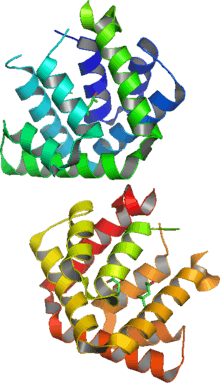Fel d 1
Fel d 1 is a secretoglobin protein that in cats is encoded by the CH1 (chain 1/Fel d 1-A) and CH2 (chain 2/Fel d 1-B) genes.[2][3]
| Allergen Fel d 1, chain 1 (P30438) | |
|---|---|
| Identifiers | |
| Symbol | Allergen_Fel_d_I_chain1 |
| InterPro | IPR006178 |
| Allergen Fel d 1, chain 2 (P30440) | |||||||||
|---|---|---|---|---|---|---|---|---|---|
 | |||||||||
| Identifiers | |||||||||
| Symbol | Feld-I_B | ||||||||
| Pfam | PF09252 | ||||||||
| Pfam clan | CL0370 | ||||||||
| InterPro | IPR015332 | ||||||||
| SCOPe | 1puo / SUPFAM | ||||||||
| |||||||||
Fel d 1, produced largely in cat saliva and sebaceous glands, is the primary allergen present on cats and kittens.[1] Fel d 1 is also produced by cat skin itself.[4] The protein is of an unknown function to the animal but causes an IgG or IgE reaction in sensitive humans (either as an allergic or asthmatic response). Kittens produce less Fel d 1 than adult cats. Female cats produce a lower level of Fel d 1 than (unneutered) males,[5] while neutered males produce levels similar to those of females; both intact and spayed females produce similar levels.
Even though females and neutered males produce Fel d 1 in lower levels, they still produce enough to cause allergic symptoms in sensitive individuals. Removal of soft surfaces in the home (carpet, furniture), frequent washings of bed linens, HEPA filters and even washing cats has been proven to reduce the amounts of Fel d 1 present in the home.
Researchers have been investigating reports from cat owners that certain breeds of cats either do not produce Fel d 1 or do so at significantly lower levels than other breeds. For instance, individual cats from the naturally occurring Siberian breed native to the Siberian region for which the breed is named have been shown to have genetic variants that result in a lower production of Fel d 1.[6] Another breed thought to have a possible genetic disposition not to produce this allergen or to produce less is the Balinese, an offshoot of the Siamese breed.[7] Several other breeds are widely referenced as causing a diminished immune reaction in cat allergy sufferers, including Sphynx, Russian Blue, Cornish Rex, Devon Rex, Siamese, Javanese, Oriental shorthair, Burmese and Laperm. Fairly reliable tests for individual cats’ Fel d 1 are available but research continues, hampered by the lack of a thoroughly accessible and surefire genetic test for the antigen’s production.
Structure
The complete quaternary structure of Fel d 1 has been determined.[1] The allergen is a tetrameric glycoprotein consisting of two disulfide-linked heterodimers of chains 1 and 2. Fel d 1 chains 1 and 2 share structural similarity with uteroglobin, a secretoglobin superfamily member; chain 2 is a glycoprotein with N-linked oligosaccharides. Both chains share an all alpha-helical structure.[1]
In other species
Proteins matching the InterPro family signature for Fel d 1 parts is widespread among Theria.
A variant of Fel-D1 is present in the venom of the slow loris (Primate: Nycticebus). Slow lorises are one of only a few venomous mammals and the only known venomous primate, possessing a dual-composite venom of saliva and brachial gland exudate (BGE).[8] The BGE possesses a protein resembling Fel-D1, which may affect host species as an allergen as a constituent of the venom, and possess a communicative function.
See also
- Allergy to cats
- Fel d 4
- Slow loris
References
- PDB: 1PUO; Kaiser L, Grönlund H, Sandalova T, Ljunggren HG, van Hage-Hamsten M, Achour A, Schneider G (September 2003). "The crystal structure of the major cat allergen Fel d 1, a member of the secretoglobin family". The Journal of Biological Chemistry. 278 (39): 37730–5. doi:10.1074/jbc.M304740200. PMID 12851385.
- Morgenstern JP, Griffith IJ, Brauer AW, Rogers BL, Bond JF, Chapman MD, Kuo MC (November 1991). "Amino acid sequence of Fel dI, the major allergen of the domestic cat: protein sequence analysis and cDNA cloning". Proceedings of the National Academy of Sciences of the United States of America. 88 (21): 9690–4. Bibcode:1991PNAS...88.9690M. doi:10.1073/pnas.88.21.9690. PMC 52784. PMID 1946388.
- Griffith IJ, Craig S, Pollock J, Yu XB, Morgenstern JP, Rogers BL (April 1992). "Expression and genomic structure of the genes encoding FdI, the major allergen from the domestic cat". Gene. 113 (2): 263–8. doi:10.1016/0378-1119(92)90405-E. PMID 1572548.
- Dabrowski AJ, Van der Brempt X, Soler M, Seguret N, Lucciani P, Charpin D, Vervloet D (October 1990). "Cat skin as an important source of Fel d I allergen". The Journal of Allergy and Clinical Immunology. 86 (4 Pt 1): 462–5. doi:10.1016/S0091-6749(05)80200-3. PMID 2229808.
- Jalil-Colome J, de Andrade AD, Birnbaum J, Casanova D, Mège JL, Lanteaume A, Charpin D, Vervloet D (July 1996). "Sex difference in Fel d 1 allergen production". The Journal of Allergy and Clinical Immunology. 98 (1): 165–8. doi:10.1016/s0091-6749(96)70238-5. PMID 8765830.
- Sartore S, Landoni E, Maione S, Tarducci A, Borrelli A, Soglia D, et al. (December 2017). "Polymorphism Analysis of Ch1 and Ch2 Genes in the Siberian Cat". Veterinary Sciences. 4 (4): 63. doi:10.3390/vetsci4040063. PMC 5753643. PMID 29194349.
- "Allergy to Cats - Cat DNA Test Kit | Basepaws". Allergy to Cats - Cat DNA Test Kit | Basepaws. Retrieved 2018-08-07.
- Nekaris KA, Moore RS, Rode EJ, Fry BG (September 2013). "Mad, bad and dangerous to know: the biochemistry, ecology and evolution of slow loris venom". The Journal of Venomous Animals and Toxins Including Tropical Diseases. 19 (1): 21. doi:10.1186/1678-9199-19-21. PMC 3852360. PMID 24074353.
Further reading
- Bonnet B, Messaoudi K, Jacomet F, Michaud E, Fauquert JL, Caillaud D, Evrard B (2018). "An update on molecular cat allergens: Fel d 1 and what else? Chapter 1: Fel d 1, the major cat allergen". Allergy, Asthma, and Clinical Immunology. 14: 14. doi:10.1186/s13223-018-0239-8. PMID 29643919.